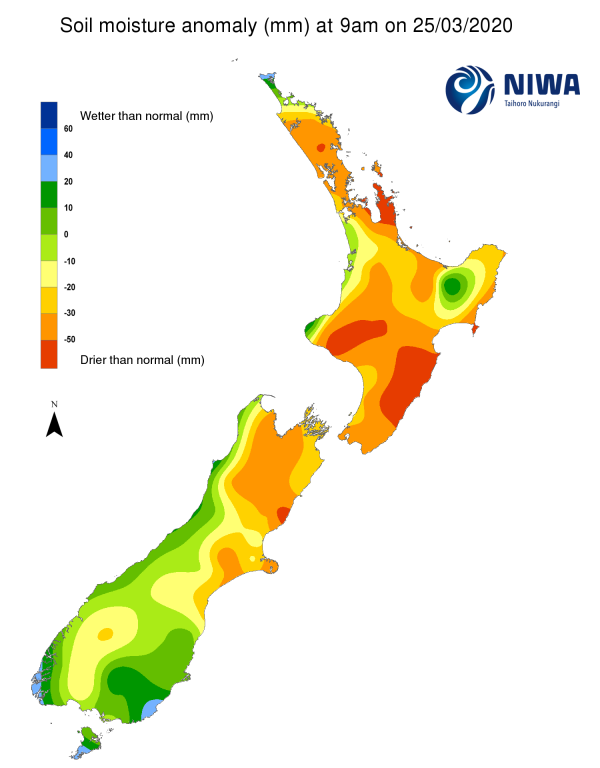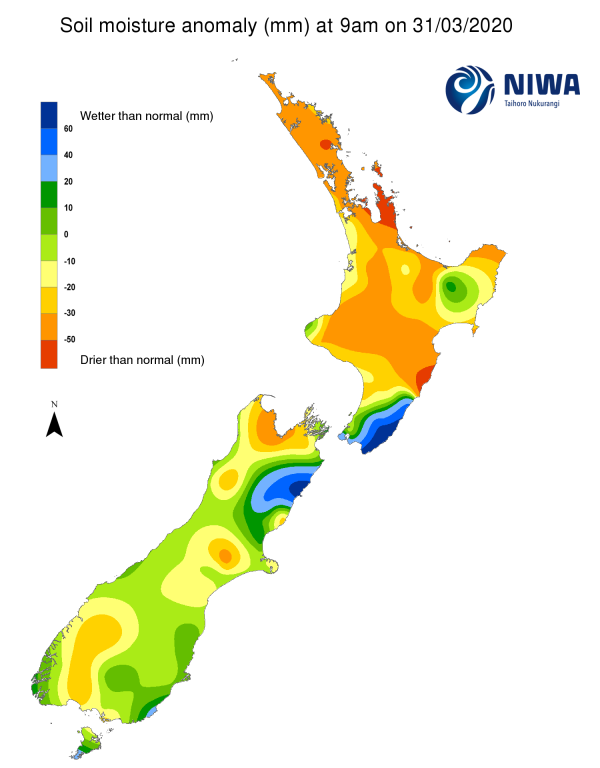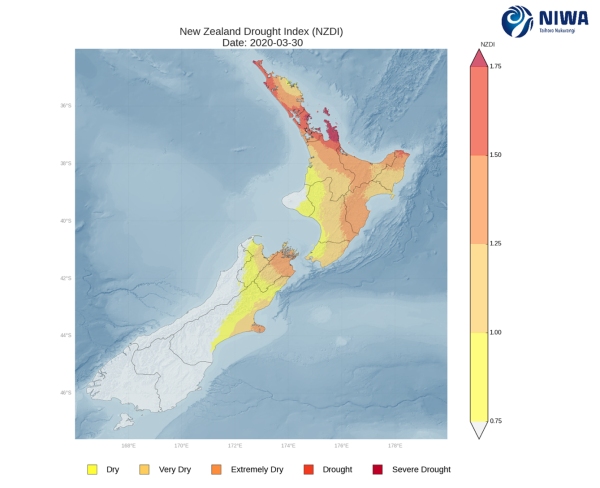A weekly update describing soil moisture patterns across the country to show where dry to extremely dry conditions are occurring or imminent. Regions experiencing significant soil moisture deficits are deemed “hotspots”. Persistent hotspot regions have the potential to develop into drought.
Facts: soil moisture
In the North Island, heavy rain in excess of 100 mm was observed during the past week in Wairarapa, with other parts of Wellington seeing 50 mm or more. Other areas including coastal Gisborne to Tararua and Taranaki to northern Manawatu-Whanganui received 30 mm or more. Conversely, generally meagre rainfall was observed in the upper North Island. This rainfall resulted in massive soil moisture increases in the lower North Island and moderate increases along much of the east coast. Meanwhile, small soil moisture decreases occurred in the upper North Island, although decreases in the Far North were more substantial. The driest soils across the North Island, when compared to normal for this time of the year, are located in the Coromandel Peninsula and a small portion of Central Hawke’s Bay. Meanwhile, the wettest soils for this time of the year are located in Wairarapa. The New Zealand Drought Index (NZDI) shows that severe meteorological drought coverage has again receded significantly in the past week, although it is still widespread in the Coromandel Peninsula. Meteorological drought remains in place across parts of Northland, Auckland, northern Waikato, and East Cape (see NZDI map).
Hotspot coverage decreased substantially in the past week in the lower North Island, but hotspots still remain across parts of the Far North, Auckland, much of the Coromandel Peninsula, southern Hastings, Central Hawke’s Bay, and parts of coastal Manawatu-Whanganui.
In the South Island during the past week, heavy rainfall of 50 mm or more occurred in northern and central Canterbury along with Marlborough Sounds. Moderate rainfall also occurred along much of the West Coast, although minimal rainfall was observed in Tasman and the lower South Island. This resulted in significant soil moisture increases across much of Marlborough and Canterbury. However, slight soil moisture decreases occurred along the West Coast and the lower South Island. The driest soils in the South Island compared to normal for this time of the year are located in Nelson and nearby parts of Tasman, while the wettest soils for this time of the year are found in Kaikoura. The NZDI shows that meteorological drought has completely dissipated across the upper South Island, although widespread dry soils are still present (see NZDI map).
Current hotspots in the South Island are found in Nelson and nearby parts of Tasman, as well as a small portion of interior Selwyn District.
Outlook and soil moisture
In the North Island, high pressure will bring mostly dry weather over the next several days. However, an onshore wind flow through the upcoming weekend (4-5 April) may produce up to 10 mm across Gisborne and Hawke’s Bay. The only chance for notable widespread rainfall will occur next Wednesday (8 April), as a passing front may produce 5-10 mm for much of the North Island.
Generally light rainfall amounts across a majority of the North Island during the next week will likely result in soil moisture decreases in many locations, with most existing hotspots strengthening and expanding at least slightly.
In the South Island, high pressure will produce dry weather through at least Saturday (4 April). Beginning on Sunday a front will deliver moderate to heavy rain to the West Coast, and by Tuesday (7 April) some rain may cross into northern, eastern, and lower portions of the South Island as well. Total weekly rainfall may exceed 75 mm in much of the West Coast, 15-25 mm in northern areas, 20-30 mm in the lower South Island, and 15 mm or less in much of Canterbury.
While weekly rainfall may result in little change or even slight increases in soil moisture levels for many locations, in much of Canterbury soils are likely to dry at least slightly. This could result in an expansion of the hotspot currently located in interior Selwyn District.
Background
Hotspot Watch: a weekly advisory service for New Zealand media. It provides soil moisture and precipitation measurements around the country to help assess whether extremely dry conditions are imminent.
Soil moisture deficit: the amount of water needed to bring the soil moisture content back to field capacity, which is the maximum amount of water the soil can hold.
Soil moisture anomaly: the difference between the historical normal soil moisture deficit (or surplus) for a given time of year and actual soil moisture deficits.
Definitions: “Extremely” and “severely” dry soils are based on a combination of the current soil moisture status and the difference from normal soil moisture (see soil moisture maps).
Hotspot: A hotspot is declared if soils are "severely drier than normal" which occurs when Soil Moisture Deficit (SMD) is less than -110 mm AND the Soil Moisture Anomaly is less than -20 mm.
Soil moisture anomaly maps, relative to this time of year. The maps show soil moisture anomaly for the past two weeks.
As of 30 March, the New Zealand Drought Index (NZDI) map below shows that severe meteorological drought and meteorological drought have both receded significantly in the North Island, although the Coromandel Peninsula remains heavily affected. In the South Island, meteorological drought and severe meteorological drought have both completely dissipated. Please note: some hotspots in the text above may not correspond with the NZDI map. This difference exists because the NZDI uses additional dryness indices, including one which integrates the rainfall deficit over the past 60 days. Changes are therefore slower to appear in the NZDI compared to soil moisture anomaly maps that are instantaneously updated.




